Gasoline Engines 101: How They Work & What You Need to Know
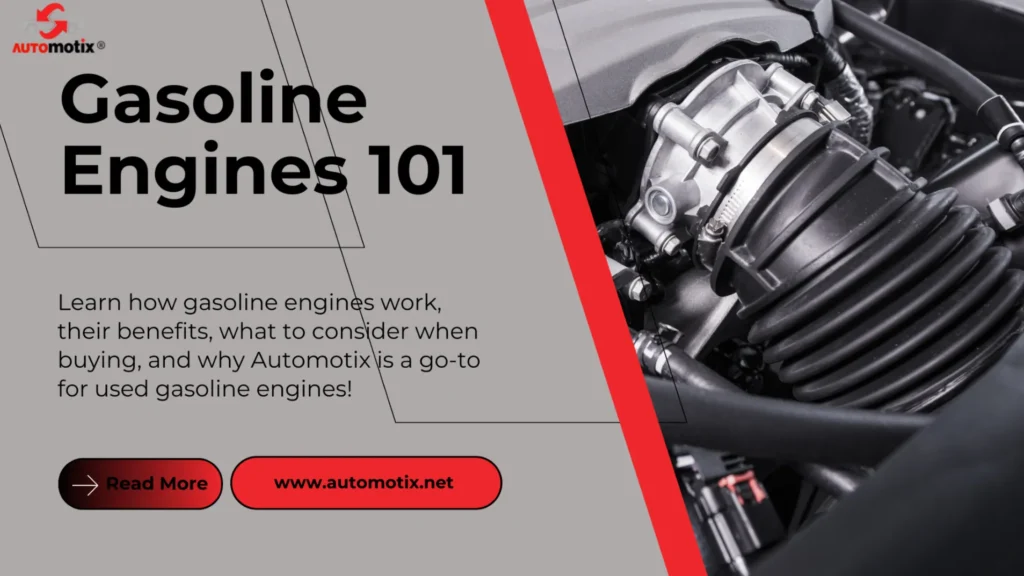
What is a Gasoline Engine
You’ve done it a thousand times. You slide into the driver’s seat, turn the key, and feel that familiar rumble as the engine sparks to life. It’s a moment we take for granted, a bit of everyday magic that connects us to the open road. But have you ever wondered what’s actually happening under the hood? That controlled, powerful explosion is the work of your car’s heart: the gasoline engine.
At its core, a gasoline engine is a type of internal combustion engine. It’s a fancy term for a simple idea: it creates power by burning fuel inside the engine itself. Think of it like a series of small, incredibly fast, and perfectly timed explosions that push pistons, turn a crank, and ultimately, spin your wheels. This ingenious process, perfected over more than a century, is what transforms a few ounces of gasoline into the force that carries you down the highway. Our goal with this guide is to pull back the curtain. We want to give you the foundational knowledge you need, without the confusing technical jargon.
By the end, you’ll not only understand the “magic” that happens when you turn the key, but you’ll also have the confidence to take control of your car’s health and make decisions like a pro. Let’s get started.
Summary
This guide from Automotix provides an in-depth look at gasoline engines, covering everything from their fundamental workings to their real-world benefits. You’ll discover:
- How they work: Learn about the internal combustion process and the four-stroke cycle that powers vehicles.
- Different types: Explore various engine configurations, including Inline, V-Type, and Boxer engines, and how their layouts affect performance.
- Maintenance tips: Get essential advice on regular oil changes, cooling system maintenance, and spark plug replacement to ensure longevity.
- Why used makes sense: Find out why a high-quality used gasoline engine can be a smart, economical, and environmentally responsible solution.
- Considerations for purchasing used: Understand what factors to prioritize, such as compression test results, visual inspection, and warranty.
Table of Contents
- How a Gasoline Engine Works
- Different Types of Gasoline Engines
- Maintaining Your Gasoline Engine for Longevity
- Why Should You Consider Used Gasoline Engines
- Considerations While Purchasing a Used Gasoline Engine
- Why Automotix is Your Best Source
- Automotix’s Nationwide Network
- Conclusion
- Frequently Asked Questions (FAQs) About Gasoline Engines
How a Gasoline Engine Works
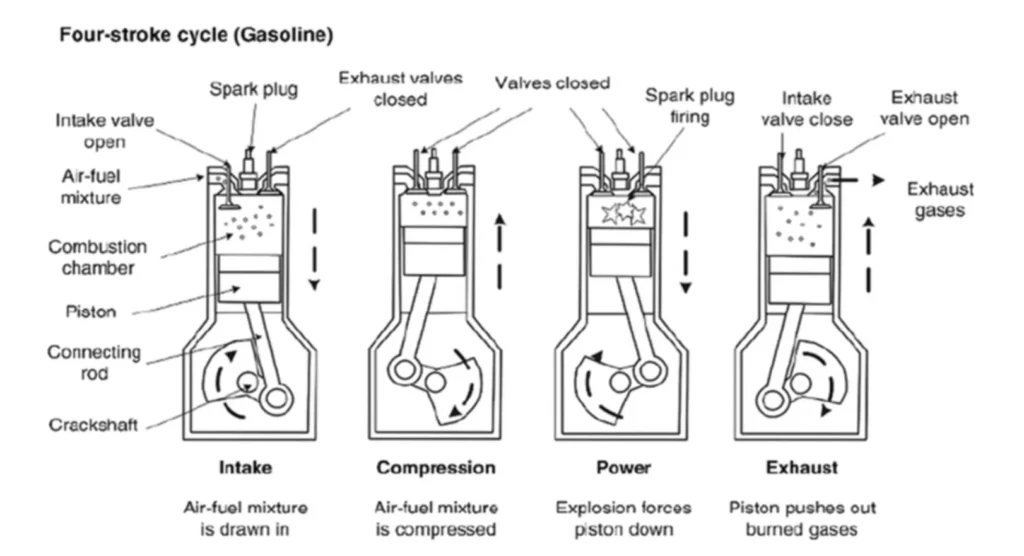
Understanding how a gasoline engine transforms liquid fuel into the force that propels your car might seem like magic, but it’s actually a remarkably clever and continuous process. It all boils down to a fundamental principle and a repeating cycle that has powered vehicles for over a century.
Core Principle
At the heart of every gasoline engine lies the concept of internal combustion. This simply means that the “burning” or ignition of fuel happens inside the engine itself, within enclosed chambers. Unlike older external combustion engines (think steam engines, where fuel was burned outside to heat water), modern gasoline engines are incredibly efficient at converting the chemical energy locked within gasoline directly into heat and pressure. This pressure then acts upon mechanical parts, forcing them to move, which ultimately spins the wheels of your vehicle. It’s a carefully timed, rapid conversion of energy that creates the power your car needs.
The Four Strokes Explained
The continuous conversion of fuel to motion in a gasoline engine is achieved through a repeating sequence known as the Four-Stroke Cycle. Each “stroke” refers to a complete up or down movement of a piston within its cylinder. This cycle is performed over and over, thousands of times per minute, in each cylinder of your engine.
1. Intake Stroke
The first step is about drawing in the vital ingredients. As the piston moves downward within the cylinder, the intake valve opens. This creates a vacuum, pulling in a precise mixture of air and atomized gasoline fuel from the intake manifold. Think of it like your engine taking a deep breath, preparing for the work ahead. The fuel, delivered by a fuel injector, is finely misted to mix thoroughly with the incoming air.
2. Compression Stroke
Once the cylinder is full of the air-fuel mixture, the intake valve closes, and the piston begins to move upward. With both the intake and exhaust valves now sealed, the air-fuel mixture is trapped and compressed into a much smaller volume at the top of the cylinder. This compression is absolutely critical; it dramatically increases the temperature and pressure of the mixture, making it far more volatile and ready for a powerful ignition. Imagine squeezing a spring – the more you compress it, the more energy it stores.
3. Power (Combustion) Stroke
This is where the magic happens! Just as the piston reaches the top of the compression stroke, the spark plug (located at the top of the cylinder head) fires, creating a high-energy electrical spark. This spark ignites the highly compressed and volatile air-fuel mixture. The resulting mini-explosion forces the piston violently downward with tremendous power. This powerful downward thrust is the force that ultimately drives your car forward – it’s the “power” in the four-stroke cycle, doing the actual work.
4. Exhaust Stroke
After the power stroke, the piston is at the bottom of the cylinder, and the combustion process has left behind spent, hot exhaust gases. As the piston moves upward again, the exhaust valve opens. This pushes the spent gases out of the cylinder and into the exhaust system, clearing the way for a fresh charge of air and fuel in the next intake stroke. It’s like exhaling after a big breath, preparing for the next cycle to begin.
Key Components Involved in the Cycle
Cylinders
These are the hollow tubes or chambers within the engine block where the pistons move up and down, and where combustion takes place. Most cars have 4, 6, or 8 cylinders.
Pistons
Metal cylindrical components that fit snugly within the cylinders. They are pushed down by the combustion force and then push the exhaust gases out.
Connecting Rods
These sturdy rods link each piston to the crankshaft, translating the piston’s up-and-down (reciprocating) motion into rotational motion.
Crankshaft
Often called the “backbone” of the engine, the crankshaft is a large, central shaft with offsets (crankpins) where the connecting rods attach. It converts the linear motion of the pistons into the rotational energy that eventually drives the wheels, much like pedals on a bicycle.
Valves (Intake & Exhaust)
Precisely timed “doors” at the top of the cylinders. The intake valve allows the air-fuel mixture in, and the exhaust valve lets the spent gases out.
Camshaft
A shaft with egg-shaped lobes (cams) that rotate to push open and close the intake and exhaust valves at the exact right moment during each stroke.
Spark Plugs
Electrical devices that sit at the top of each cylinder. They deliver the precise electrical spark needed to ignite the air-fuel mixture during the power stroke.
Fuel Injectors
These small, electronically controlled nozzles precisely spray atomized (fine mist) gasoline into the intake air, ensuring the correct fuel-to-air ratio for efficient combustion.
Different Types of Gasoline Engines
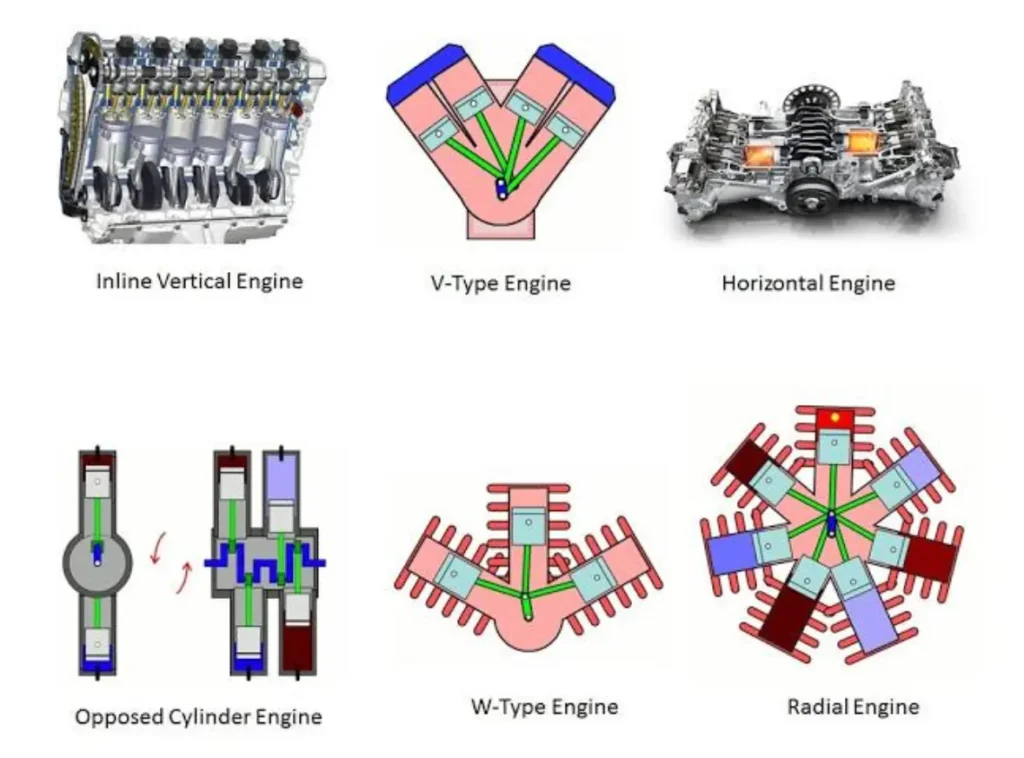
While all gasoline engines work on the same basic four-stroke principle, their physical layout—the way the cylinders are arranged—can be very different. This engineering choice isn’t just for show; the configuration of an engine dramatically affects its size, smoothness, performance characteristics, and even how a car feels to drive.
Think of it this way: everyone knows how to build a wall with bricks, but the pattern you lay them in changes the wall’s strength and appearance. It’s the same with engines. Let’s break down the most common layouts you’ll find on the road.
Inline Engines (I4, I6)
The inline engine is the most straightforward design. All the cylinders are arranged in a single, straight line, one after the other.
Inline-Four (I4)
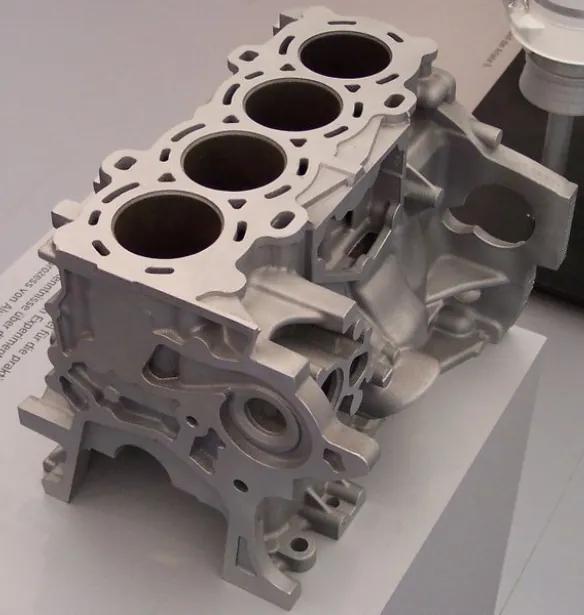
This is, by far, the most popular engine in the world, and for good reason. With four cylinders, it’s compact, lightweight, fuel-efficient, and relatively simple to manufacture and repair. Its simplicity means fewer moving parts compared to other designs, which often translates to excellent reliability and lower maintenance costs. You’ll find the I4 in the vast majority of compact and mid-size cars.
Inline-Six (I6)
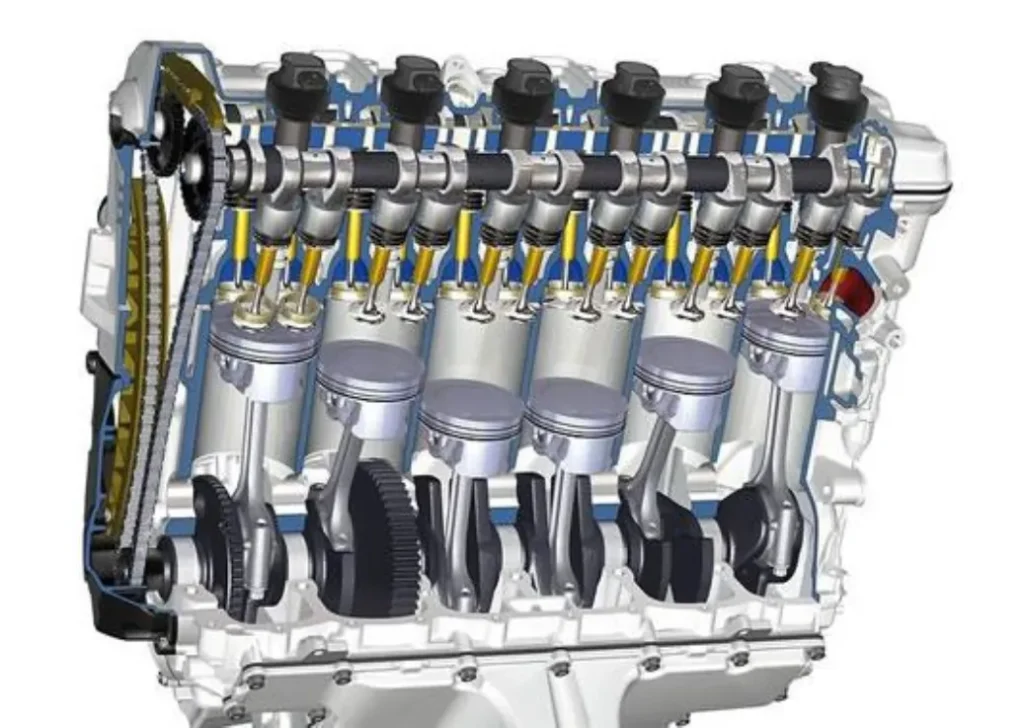
A cutaway view of an inline-six engine showing pistons, connecting rods, and crankshaft.
An I6 is a longer version, with six cylinders in a row. This layout is renowned for its exceptional smoothness. Because of the firing order and piston movement, the engine’s primary forces are naturally balanced, leading to a silky, vibration-free operation that many enthusiasts love. While they are longer and require more space, their inherent balance is a mark of premium engineering, famously used by brands like BMW and in legendary truck engines like the old Jeep 4.0L.
V-Type Engines (V6, V8)
When you need more power without taking up a ton of space, you turn to the V-type engine. This design splits the cylinders into two banks, or rows, that are angled away from each other, forming a “V” shape.
V6 Engine
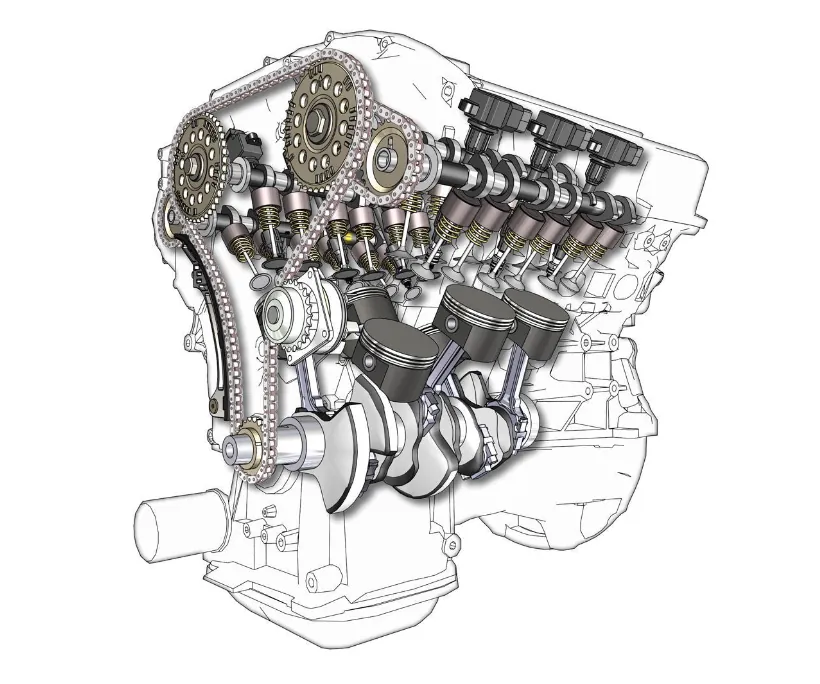
A cutaway view of a V6 engine showing the angled cylinder banks, pistons, and crankshaft.
A V6 engine essentially takes six cylinders and arranges them in two banks of three. This makes the engine much shorter than an I6, allowing it to fit sideways in front-wheel-drive vehicles or easily into the smaller engine bays of modern cars. It’s the perfect compromise, offering a significant power boost over an I4 without the size and fuel consumption of a V8. It has become the standard engine for countless sedans, minivans, and crossover SUVs.
V8 Engine
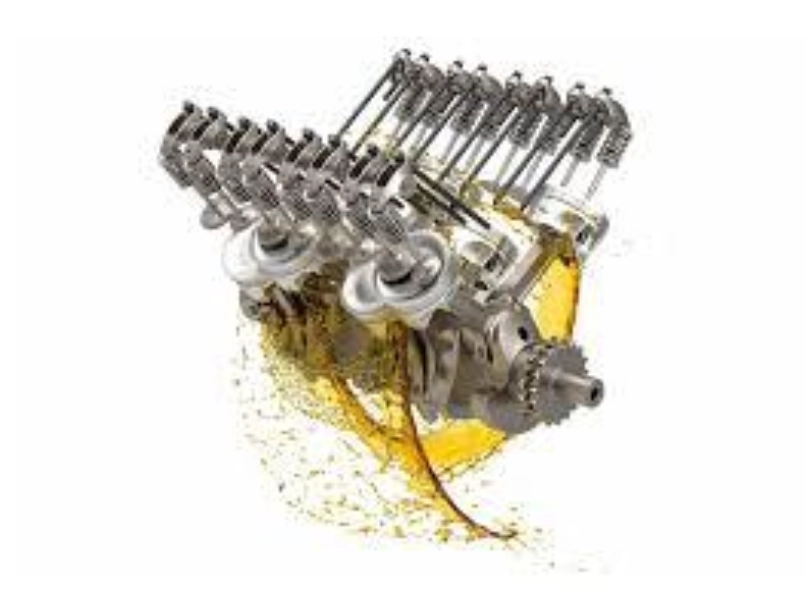
The undisputed king of American muscle and full-size trucks, the V8 arranges eight cylinders in two banks of four. This configuration is all about producing serious power and torque (the twisting force that gets a heavy vehicle moving). The V8’s design allows it to displace a large volume, and its signature burbling sound is iconic. While not as fuel-efficient, it’s the top choice for towing, hauling, and high-performance applications.
Boxer (Flat) Engines
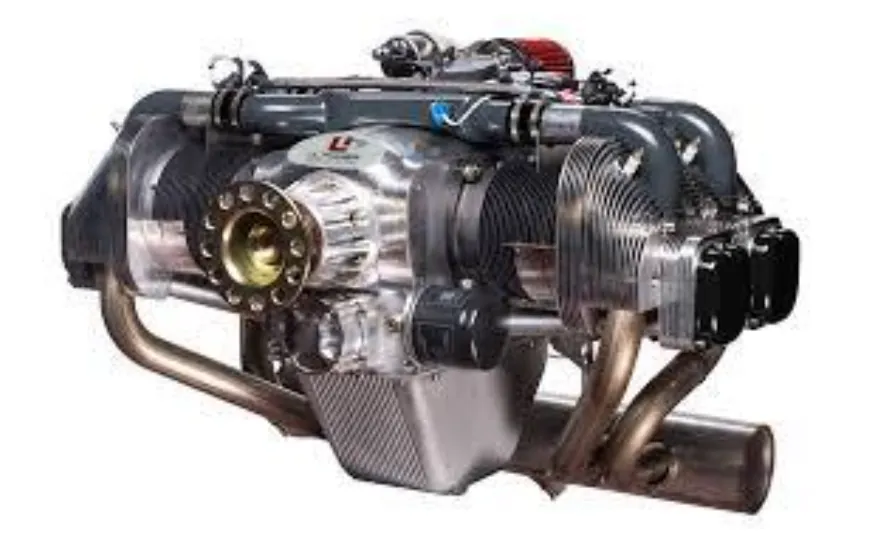
The Boxer engine is a unique and less common design, but it has a fiercely loyal following. In this layout, the cylinders are laid flat and positioned opposite each other. When the pistons move, they shuttle in and out simultaneously, like boxers throwing punches—hence the name.
The main advantage of this design is its incredibly low profile. A flat engine gives a vehicle a much lower center of gravity, which significantly improves handling, stability, and cornering performance. This is why you’ll find boxer engines almost exclusively in performance-oriented, all-wheel-drive vehicles from brands like Subaru and in the iconic sports cars made by Porsche.
Maintaining Your Gasoline Engine for Longevity
Proactive maintenance isn’t just about fixing problems; it’s about preventing them, preserving performance, and extending the life of your engine for tens, if not hundreds, of thousands of miles. It’s a small investment in time and money that pays massive dividends in reliability and avoiding costly breakdowns. A well-maintained engine is also a more efficient engine, meaning better fuel economy for you.
Regular Oil Changes
Fresh, clean oil ensures components move smoothly, preventing excessive wear, heat buildup, and sludge formation. Neglecting oil changes leads to accelerated wear, overheating, and eventual engine failure.
Always refer to your vehicle’s owner’s manual for the recommended oil viscosity (e.g., 5W-30, 0W-20) and specifications (e.g., API, ACEA ratings). Using the wrong oil type can compromise lubrication and efficiency.
Cooling System Maintenance
Regularly check your coolant reservoir’s level when the engine is cold. If it’s low, top it off with the manufacturer-recommended coolant type. A consistently low level indicates a leak that needs immediate attention.
Inspect the radiator for bent fins (which restrict airflow) and signs of leaks. Keep the radiator free of debris (leaves, bugs) that can block airflow and reduce cooling efficiency. Check all radiator and heater hoses for cracks, bulges, softness, or hardening. Ensure clamps are secure.
Over time, coolant loses its anticorrosive properties and can become acidic, damaging internal components. Follow your manufacturer’s recommended flush intervals (typically every 30,000 to 100,000 miles, depending on coolant type) to replace old coolant with fresh fluid.
Spark Plug Replacement
Consult your owner’s manual. Conventional copper plugs typically need replacement every 30,000 miles, while platinum and iridium plugs can last 60,000-100,000 miles or more.
Worn spark plugs can lead to misfires, reduced fuel economy, sluggish acceleration, and increased emissions. Replacing them ensures efficient combustion, optimal performance, and lower emissions.
Air Filter and Fuel Filter Replacement
This filter prevents dirt, dust, and debris from entering your engine’s combustion chambers, where they could cause abrasive wear. A clogged air filter restricts airflow, leading to reduced engine performance, decreased fuel economy, and potentially higher emissions. Check it every oil change and replace it annually or every 15,000-30,000 miles, more often if you drive in dusty conditions.
Belt and Hose Inspection
The serpentine belt drives accessories like the alternator, water pump, power steering pump, and A/C compressor. Inspect it regularly for cracks, fraying, missing ribs, or glazing. A failing belt can leave you stranded without power steering, a charging system, or even cooling. Replace belts as recommended by your manufacturer, typically every 50,000-100,000 miles, or at the first sign of wear.
Timely Tune-ups
A modern tune-up typically involves inspecting and potentially replacing spark plugs, checking ignition system components, inspecting belts and hoses, checking fluid levels and condition (oil, coolant, brake fluid, power steering fluid), inspecting filters, checking the PCV valve, and performing a general visual inspection for leaks or unusual wear.
Why Should You Consider Used Gasoline Engines
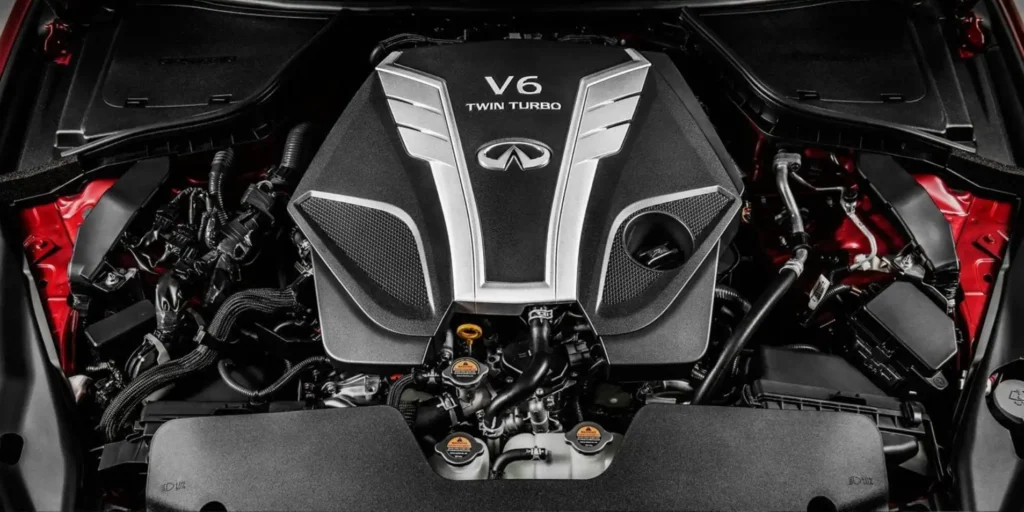
When your vehicle’s gasoline engine faces a catastrophic failure – perhaps due to an accident, prolonged neglect, or simply reaching the end of its natural lifespan – the initial reaction can be one of dread. Repairing an engine can be incredibly costly, and buying a brand-new vehicle might not be financially feasible or desirable. This is where the often-overlooked, yet highly practical, solution of a used gasoline engine comes into play. Far from being a last resort, choosing a used engine can be a remarkably smart, economical, and responsible decision for many vehicle owners.
Cost-Effectiveness
The most immediate and apparent benefit of opting for a used engine is the substantial cost savings. A brand-new, factory-direct engine (known as an “OEM” engine) can be prohibitively expensive, often costing more than the entire value of an older vehicle. Similarly, a professionally rebuilt or remanufactured engine, while offering renewed components, still carries a significant price tag due to the extensive labor and new parts involved in its overhaul.
Availability
As vehicles age, original equipment manufacturers (OEMs) often discontinue production of certain parts, including complete engines. This can leave owners of older or less common car models in a difficult position when major engine issues arise, as new parts simply might not exist or are extremely hard to find.
Environmental Benefits
Choosing a used gasoline engine is also a deeply responsible environmental decision. The automotive industry, like many others, has a significant environmental footprint, from raw material extraction to manufacturing processes.
Quality Assurance
The term “used” can sometimes carry a negative connotation, conjuring images of worn-out or unreliable parts. However, the critical distinction lies in where you source your used engine. When sourced correctly from a reputable supplier, a used gasoline engine can be just as reliable, and often a much smarter investment, than a new or rebuilt one.
Considerations While Purchasing a Used Gasoline Engine
Choosing to replace your vehicle’s failing heart with a used gasoline engine is a smart financial and practical decision. However, not all used engines are created equal. To ensure you’re making a wise investment that truly gets you back on the road reliably, it’s crucial to know what factors to prioritize. This isn’t just about finding the cheapest option; it’s about finding the right option from the right source.
Reputable Supplier
A reputable supplier is transparent about their sourcing, inspection processes, and the condition of their engines. They understand that you’re making a significant investment and will provide all available information to help you make an informed decision.
Look for a company with clear communication channels, knowledgeable staff who can answer your technical questions, and a track record of positive customer reviews. They should be willing to provide detailed information about the engine’s origin and any tests performed.
Mileage and Vehicle History
An engine with fewer miles typically indicates less wear and tear, suggesting a longer potential lifespan. However, a high-mileage engine that was meticulously maintained can sometimes outperform a lower-mileage engine that was neglected. A reputable supplier will often provide as much information as available about the donor vehicle from which the engine was pulled. This might include the vehicle’s VIN, which can sometimes be used to check for accident history (e.g., if it was in a major frontal collision that impacted the engine) or if it was part of a flood. While detailed service records for a salvaged vehicle are rare, any available context is helpful.
Compression Test Results
A compression test measures the amount of pressure each cylinder can build. Good compression indicates that the piston rings are sealing properly against the cylinder walls and that the valves are sealing tightly when closed.
Low or inconsistent compression across cylinders can signal significant internal wear or damage, such as worn piston rings, damaged valves, or a compromised head gasket. An engine with poor compression will run poorly, lack power, and likely consume excessive oil.
Visual Inspection
Look for signs of oil, coolant, or fuel leaks. Fresh leaks or significant old, crusty residue can indicate failing gaskets or seals. Inspect the engine block, cylinder head, oil pan, and other external components for cracks, dents, stripped bolts, or broken mounting points. These could be signs of mishandling or prior impact.
Excessive rust on exposed metal parts, especially on electrical connectors, can indicate exposure to water or long-term neglect, which could lead to electrical issues down the line.
While not every used engine will be spotless, excessive sludge or dirt on the exterior could hint at poor maintenance, though a superficially clean engine can also hide problems. Focus on the signs of significant oil leaks that have been left unaddressed.
Warranty and Return Policy
A comprehensive warranty protects your investment against unforeseen defects. It demonstrates the supplier’s confidence in the quality of their product.
What to Look for:
- Duration: How long is the warranty valid (e.g., 30 days, 90 days, 1 year)? Longer is generally better.
- Coverage: Does it cover parts only, or does it also include labor for removal and installation if a defect is found?
- Terms and Conditions: Understand what voids the warranty (e.g., improper installation, neglect, overheating after installation).
- Return Policy: What are the conditions for returns if the engine is not compatible or has issues upon arrival?
Compatibility
This is a non-negotiable factor. Even minor differences can lead to a non-fitting or non-functional engine. You need to match the engine precisely to your vehicle’s VIN (Vehicle Identification Number), year, make, model, and engine code (found on a sticker or cast into the block/head).
Why Automotix is Your Best Source

We’ve explored how a used gasoline engine can be a smart, cost-effective, and environmentally friendly solution for many automotive needs. Now, let’s look at why Automotix.net stands out as the premier destination for finding that perfect engine. Our commitment to quality, extensive selection, expert support, and reliable service is designed to give you complete peace of mind with your purchase.
Our Sourcing and Testing Process
Quality isn’t just a buzzword for us; it’s the foundation of our operation. We understand that the reliability of a used engine hinges on its origin and the scrutiny it undergoes before it ever reaches our inventory.
We partner with a nationwide network of reputable salvage yards and automotive recyclers. Our acquisition specialists meticulously select donor vehicles based on various criteria, prioritizing those with verifiable low mileage, non-impacted engine compartments (in the case of accident vehicles), and clear maintenance histories where available.
Extensive Inventory
Thanks to our vast network of partners across the USA, our inventory is constantly updated, providing unparalleled access to engines from virtually every make, model, and year. Whether you drive a popular domestic sedan, a specialized import, or a classic truck, you’re likely to find a compatible engine in our system.
Our intuitive online search platform allows you to quickly narrow down options by vehicle make, model, and year, ensuring you find the precise match for your vehicle’s specifications. We utilize the industry-standard Hollander Interchange Cataloging system to ensure precise compatibility, taking the guesswork out of your purchase.
Expert Support
Our customer service representatives aren’t just order-takers; they are knowledgeable experts who can help you verify compatibility using your VIN and engine codes, answer technical questions, and guide you through the selection process.
We understand that every customer’s situation is unique. Our team is committed to providing personalized support, ensuring you feel confident and informed at every step of your purchase, from initial inquiry to post-delivery questions.
Warranty and Customer Satisfaction
Unlike some suppliers, Automotix.net offers comprehensive warranties on our used gasoline engines. This warranty is a direct reflection of our confidence in our sourcing and testing processes, providing crucial protection for your investment. We believe that a reliable used part should come with reliable backing.
Our warranty and return policies are straightforward and transparent, ensuring you understand your coverage and options. In the rare event of an issue, our dedicated support team is ready to assist you through the resolution process.
For instance, Sarah, a customer from Ohio, recently shared her experience: ‘My old engine suddenly gave out, and I was dreading the cost. Automotix not only had the exact used engine I needed, but their warranty gave me such confidence. It’s been running perfectly for months, and I saved a fortune!’
This kind of feedback underscores our commitment to not just selling parts, but delivering reliable solutions.
Fast and Reliable Delivery Across the USA
Automotix utilizes a network of trusted freight carriers to ensure your used engine reaches you quickly and safely, no matter where you are in the contiguous USA. Every engine is professionally created and secured to prevent damage during transit, ensuring it arrives at your mechanic’s shop or your doorstep in the same condition it left our facility. We provide tracking information so you can monitor your shipment’s progress, keeping you informed until your engine arrives.
Automotix’s Nationwide Network
While guaranteed compatibility is crucial, Automotix goes a step further. Our nationwide network of professional auto recyclers and suppliers means we don’t just find a diesel engine that fits your application; we often provide multiple options for the same vehicle. This allows you to choose an engine based on various factors beyond just fit, such as mileage, specific quality assurances, and even price points, ensuring you get the best possible value that aligns with your needs and budget. We empower you with choices, so you’re not just getting a replacement part, but the right replacement part for you.
Conclusion
The familiar rumble of your engine doesn’t seem so mysterious anymore, does it? From the elegant four-stroke dance of pistons to the critical roles played by every belt, hose, and sensor, you now have the knowledge to understand the heart of your vehicle. We’ve simplified the process of internal combustion, highlighted the essential components that work in harmony, and underscored the vital importance of proactive maintenance in ensuring a long and healthy life for your engine.
You now understand that a high-quality used gasoline engine isn’t a gamble; it’s a smart, cost-effective, and environmentally responsible solution that can breathe new life into a vehicle you love. You know what to look for—from compression tests to warranty coverage—and you know the right questions to ask.
At Automotix, we believe an informed customer is a confident customer. Our commitment is to provide not just the parts, but the peace of mind that comes from knowing you’ve made the right choice. With our rigorous testing, vast nationwide inventory, and expert support, we’re here to connect you with the perfect engine for your needs.
Ready to get back on the road with confidence? Explore our extensive inventory of used gasoline engines today, or contact our team of specialists. We’re here to help you find the power and reliability you deserve.
Frequently Asked Questions (FAQs) About Gasoline Engines
Q: How long does a typical gasoline engine last?
A: The lifespan of a gasoline engine can vary significantly based on the make, model, original quality, and most importantly, maintenance. With regular, diligent maintenance (like timely oil changes, proper cooling system care, and addressing minor issues promptly), many modern gasoline engines can easily last 150,000 to 200,000 miles or even more. However, neglected engines might fail much sooner, while exceptionally well-cared-for engines can surpass 300,000 miles.
Q: What’s the main difference between a used, rebuilt, and new engine?
A: Understanding these distinctions is crucial when considering a replacement:
- New Engine (Crate Engine/OEM): A brand-new engine built by the original manufacturer or an authorized supplier. It comes with a full factory warranty and is the most expensive option.
- Rebuilt/Remanufactured Engine: An engine that has been disassembled, thoroughly inspected, cleaned, and had worn or damaged parts (like pistons, rings, bearings, gaskets) replaced with new or reconditioned components. It’s then reassembled to original factory specifications. These are generally more expensive than used engines but less than new ones, and come with a specific warranty from the rebuilder.
- Used Engine: An engine that has been pulled directly from another vehicle (often a salvage or totaled vehicle) that is still in functional condition. Its components are original to that engine, and its quality depends heavily on its previous life and the rigor of the supplier’s testing. Used engines are typically the most cost-effective option and come with a warranty from the seller, like Automotix.net.
Q: Are used engines reliable, or are they just a temporary fix?
A: When sourced from a reputable supplier with rigorous testing and quality assurance processes, used engines can be very reliable and offer a long-term solution, not just a temporary fix. Their reliability depends on factors like their original mileage, maintenance history (if known), and crucially, the thoroughness of the inspection and testing they undergo before sale. Companies like Automotix.net invest heavily in diagnostics (like compression tests) to verify the health of the engine, ensuring you receive a dependable component. A good warranty also signals the supplier’s confidence in the product’s reliability.
Q: How can I tell if my engine needs to be replaced instead of repaired?
A: Deciding between repair and replacement often comes down to the severity of the damage and the cost. Consider a replacement if:
- You experience catastrophic damage (e.g., a thrown rod, cracked block from severe overheating, hydro-lock).
- The estimated repair costs exceed the vehicle’s market value (or are close to it).
- Your engine has multiple, persistent, and costly issues that indicate widespread internal wear (e.g., severe oil consumption combined with low compression across several cylinders).
- You’re restoring an older vehicle where new parts are unavailable or prohibitively expensive.
If you’re unsure, get detailed repair estimates and compare them to the cost of a quality used engine plus installation.
Q: How do I make sure a used engine is compatible with my specific vehicle?
A: Ensuring compatibility is paramount. You’ll need key information about your vehicle:
- Vehicle Identification Number (VIN): This 17-character code (found on your dashboard, door jamb, or registration) provides specific details about your car’s original build.
- Year, Make, and Model: Basic identifiers.
- Engine Size (Liters or Cubic Inches): E.g., 2.0L, 3.5L, 5.7L.
- Engine Code: Many manufacturers use specific alphanumeric codes to denote exact engine variations (e.g., “K24A2” for a Honda engine). This is often found on a sticker under the hood or cast into the engine block.
- Transmission Type: Manual or Automatic, as certain engine variations and mounting points can differ.
- Specific Options: Such as turbocharged vs. naturally aspirated, different emissions packages, or specific valve train technologies.
A reputable supplier, like Automotix.net, will have experienced staff and robust databases to cross-reference your vehicle’s VIN and specs against their engine inventory to guarantee a perfect match.
Q: What kind of warranty can I expect on a used engine from Automotix.net?
A: At Automotix.net, we stand behind the quality of our rigorously tested used engines with a comprehensive warranty. While specific terms can vary, our warranties are designed to provide you with peace of mind and protect your investment against unforeseen defects. We encourage you to visit our dedicated Warranty Policy page on Automotix.net to review the specific terms and coverage duration for our used gasoline engines. This transparency is part of our commitment to customer satisfaction.
✅ Pro Tip: Always match your VIN when searching for a used engine to guarantee fitment.
About the Author / Automotix Team:
This guide was crafted by the seasoned experts at Automotix, a leading name in the used auto parts industry since 2000. With over two decades of dedicated experience, our team has been at the forefront of connecting buyers with high-quality, certified used OEM auto parts across the USA. We pride ourselves on leveraging cutting-edge technology to streamline the auto parts buying experience, offering an unparalleled inventory and a commitment to customer satisfaction that has established us as a trusted authority. Our mission is to empower carowners, DIY mechanics, and repair shops with the knowledge and the right parts to keep vehicles running efficiently and affordably, contributing to both individual savings and a more sustainable automotive future.


